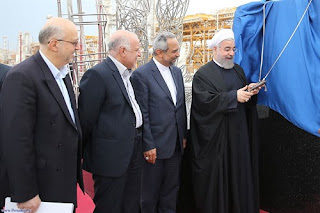Reasons for Iran to focus on South Pars gas field
Iran says it is preparing to commence 15 new phases of South Pars gas field in three years, while 5 phases of the giant field have become operational during the last two years.
Iranian Oil Minister Bijan Namdar Zanganeh said on August 27 that Iran would overtake Qatar in South Pars by 2018.
South Pars, a joint gas field between Iran and Qatar, holds about 10 percent of global conventional gas reserves. Qatar started the gas production from this field a decade earlier that Iran, while Iran hadn't commenced any new phases from 2009 to 2014.
According to BP as well as Iran’s official statistics, the country’s sweet gas output reached about 173 billion cubic meters (bcm) to 178 bcm during last year, of which about 110 bcm was produced in South Pars.
However, Qatar, whose gas production relies on South Pars (North Field), produced 178 bcm of gas during last year. Thus, Iran needs to increase its gas production by about 80 bcm per annum (bcm/a) from South Pars to surpass Qatar.
While Iran has 28 joint oil and gas fields with neighbors, the country hasn't commenced any new oil filed since 2007 and the development pace of other fields are very slow.
However, Iran has accelerated developing the remained phases (10 to 29) of South Pars, the world's biggest gas reserve.
Since 2014 until now, Iran started early gas production from phases 12, 15, 16, 17 and 18, while the phase 19 is expected to become operational by March 2016. During this period, Iran increased raw gas production by 120 mcm/d and additional 80 mcm/d of gas production is expected to be produced by March 2016, which Iran's current fiscal year will end.
Meanwhile, Iran has three reasons to focus on the South Pars project.
First of all, despite about 30 trillion cubic meters of gas reserves, the gas pressure is going to decline and in 2023 it will reach such a level that installing gas compressors will be unavoidable, according to a report released by IRNA. The report said that extracting gas from South Pars in 2033 would become uneconomical without the new technologies.
The second reason is replacing expensive and pollutant liquid fuels with natural gas. For instance, Iran has increased gas consumption in power plants by 33.6 percent to about 49 bcm last fiscal year, while during the first 5 months of current fiscal year (March 21 to Aug.22) the gas delivery to power plants increased by 12.2 percent again.
Iran needs 70 bcm of gas to deliver power plants to curb diesel and fuel oil burning there. Power plants share 40 percent in the country's total emissions (about 500 million tons per year). Air pollution costs $16 billion for Iran annually, according to the World Health Organization.
Iran also needs to gasify 1,900 industrial units and about 3 million households by 2018. On the other hand, Iran needs by-products in South Pars, like methane, ethane, propane, gas condensate, etc.
Iran's petrochemical production capacity is about 60 million tons per year, but last year Iran produced only 44 million tons of petrochemicals, mostly due to feeds shortage and export limits, caused by sanctions.
Iran could deliver only 2.8 million tons of ethane to petrochemical complexes last year, but the figure is planned to reach 4.2 million tons in current year.
Iran has plan to increase petrochemicals output to 120 million tons by 2020.
This is while Iran is preparing to launch its biggest refinery, Setareh Khalij Fars (Persian Gulf Star) which will need 360,000 barrels per day of gas condensate. Currently, Iran has to import diesel and gasoline.
Iran will produce about 1.8 million barrels of gas condensate and 800 mcm/d od natural raw gas after full commencing South Pars.


Comments
Post a Comment